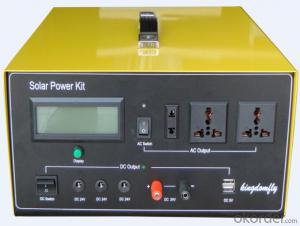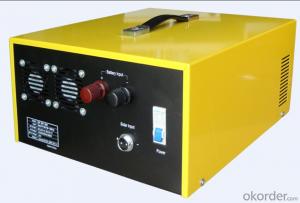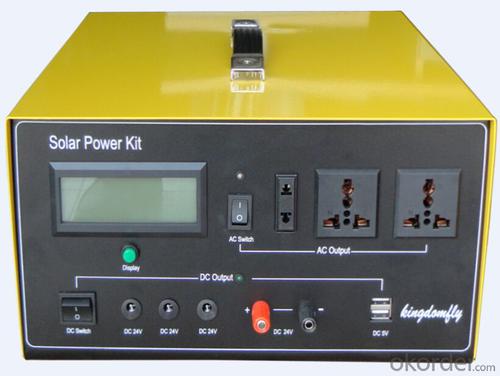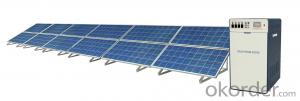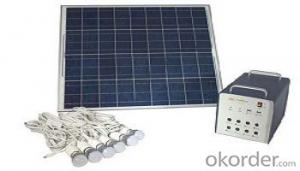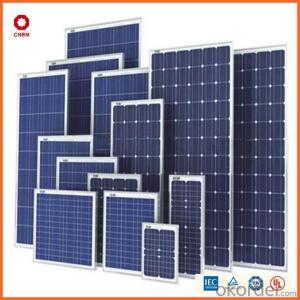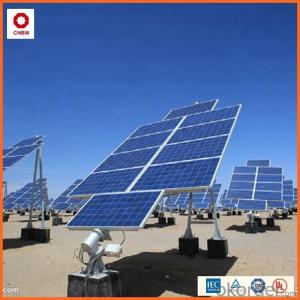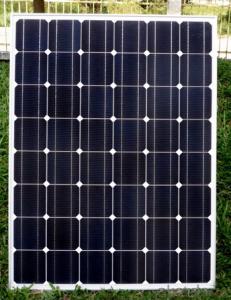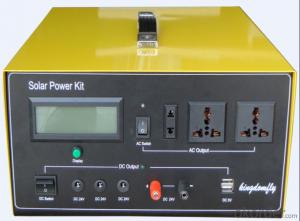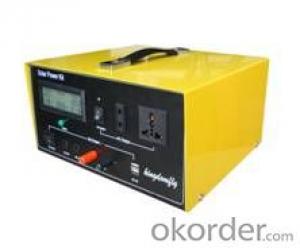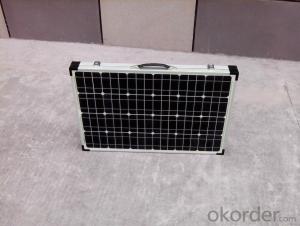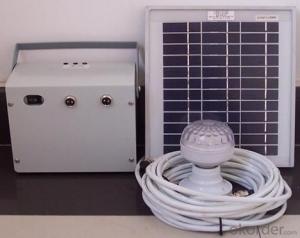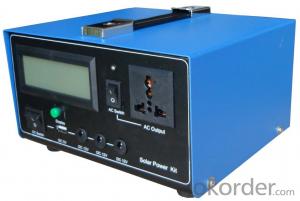Solar Energy Systems Indiana - Home Solar Power System SPK_1000
- Loading Port:
- China main port
- Payment Terms:
- TT OR LC
- Min Order Qty:
- 3 pc
- Supply Capability:
- 10000 pc/month
OKorder Service Pledge
OKorder Financial Service
You Might Also Like
Main Information
KDF SPK_1000 This product is high performance,family used portable solar power system,which can receive energy and store it in battery outside connected to SPK by solar energy on sunny day,and supplies electric power for varies appliances such as electric fan,lighting lamps, television, portable computer etc.It can supply power for both DC and AC electric application .It’s very helpful and useful for home electric supply.
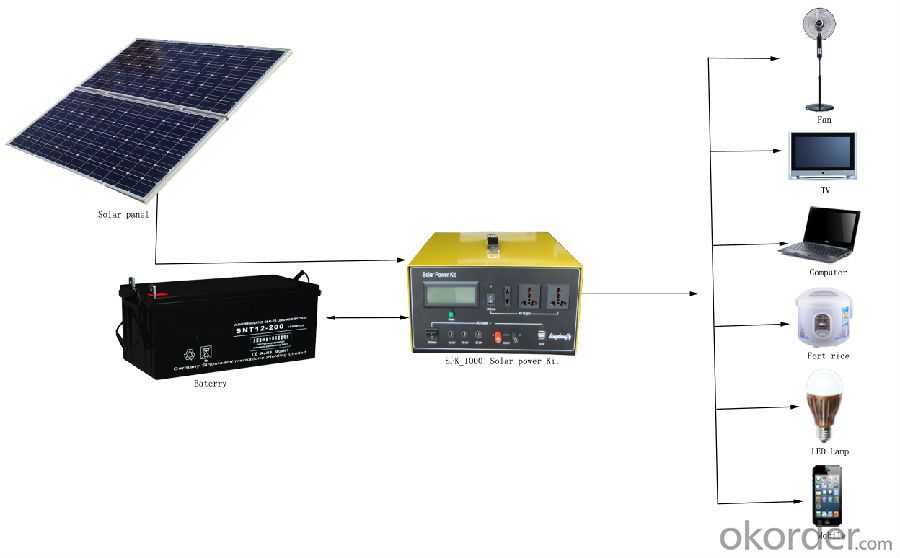
Features:
◆ Battery puts outside connected to the SPK for user to choose battery in recommended range, and easily to exchange battery.
◆ Both DC and AC output
◆ Solar Feedback Circuit Protection
◆ Output Short-circuit Protection
◆ Solar「+」「-」anti-access protection
◆ Output「+」「-」anti-access protection
◆ Over Charged Protection
◆ Over Discharged Protection
◆ Over Load Protection
◆ Over-Temperature Protection
Technical parameters
Specification | Value/Material | |
Item No. KDF | SPK_1000 | |
Solar Recommended | Specification | Poly silicon |
Working Voltage/Power | 36V/80W~500W | |
Battery Recommended | Rated Voltage/Capacity | 24V50AH~200AH |
Cycle Number | 80% Deep Cycle Number:500 70% Cycle Number:800 | |
Working Temperature | Short Period(one Month):-20~50℃Long Period(Six Months):-10~45℃ | |
Charging Controller | Operating Voltage | 24V |
Input Voltage | 34.6V~42V | |
Input current | MAX:20A | |
Power Consumption | MAX: 15mA | |
Low Voltage Disconnect(LVD) | 21.6V | |
Low Voltage Reconnect(LVR) | 24.6V | |
High Voltage Discharge( HVC) | 29.2V | |
High Voltage Recharge(HVR) | 27.6V | |
Temperature Protection | 60℃ | |
DC Output | DC output & Application | USB 5V2A |
DC output & Application | DC 24V | |
AC Output | Output Wave | Modified sine wave |
Input Voltage | 22V~30V | |
Output Voltage | 220V±10% | |
Output Frequency | 60Hz±2Hz/50Hz±2Hz | |
Rated Output Power | 1000W | |
Maximum VA | 2000VA | |
Maximum Efficiency | 88% | |
Temperature | 0-40℃ | |
Over Temperature | 60℃~70℃ | |
Low Voltage Alarm | 22V | |
Low Voltage Shut off | 21V | |
High Voltage Shut off | 30V | |
Package | Set size | 350*449*227mm |
Set N·W | 7.2kg | |
Set N·W | 5.2kg | |
LCD_Display
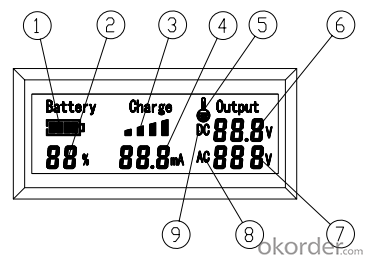
No. | Name | Function |
1 | Battery Icon | To show the Volume of the Battery |
2 | Date of % | To show the percent of the Battery |
3 | Charging Icon | To show the charging condition |
4 | Current | To show the value of charge current |
5 | Temperature Icon | Temperature Alarm |
6 | Date of Voltage | To Show the Value of DC output voltage |
7 | Date of Voltage | To Show the Value of AC output voltage |
8 | AC Icon | AC output |
9 | DC Icon | DC output |
- Q: Can solar energy systems be used in areas with strict building codes or historical preservation restrictions?
- Yes, solar energy systems can be used in areas with strict building codes or historical preservation restrictions. In such cases, the installation of solar panels may require careful planning and compliance with specific guidelines to ensure architectural aesthetics and historical significance are preserved. This can be achieved through the use of alternative mounting options, such as ground-mounted or solar carport systems, that do not impact the building's exterior. Additionally, advancements in solar technology have allowed for the development of sleek and discreet panels that blend seamlessly with the surrounding architecture, making them more acceptable in historically preserved areas.
- Q: What is the cost of installing a solar energy system?
- The cost of installing a solar energy system can vary depending on various factors such as the size of the system, location, and specific requirements. On average, the cost can range from $10,000 to $30,000 or more. However, there are also various incentives, tax credits, and financing options available that can help offset the initial cost. It is recommended to consult a solar energy provider or contractor to get an accurate estimate based on your specific needs and circumstances.
- Q: Can solar energy systems be used in powering car charging stations?
- Yes, solar energy systems can definitely be used to power car charging stations. In fact, many car charging stations around the world are already powered by solar energy. Solar panels can be installed on the roof or nearby the charging station, which then captures sunlight and converts it into electricity. This renewable energy can be used to charge electric vehicles (EVs) without relying on the traditional power grid. Solar-powered car charging stations offer several advantages. Firstly, they provide a sustainable and clean source of energy, reducing carbon emissions and the overall environmental impact of EVs. Secondly, they can be installed in remote or off-grid locations where it may be challenging or expensive to connect to the electrical grid. This makes solar-powered charging stations particularly beneficial for rural areas or highways that lack easy access to electricity. Furthermore, solar energy systems can be designed to include battery storage, allowing the excess energy generated during the day to be stored and used during the night or during times of high demand. This ensures a continuous and reliable source of power for car charging stations, even when sunlight is not available. Although the initial installation cost of solar energy systems may be higher compared to traditional power sources, they generally have lower operating and maintenance costs in the long run. Additionally, there are various government incentives and rebates available to promote the use of renewable energy, which can help offset these initial costs. Overall, solar energy systems are a viable and sustainable solution for powering car charging stations, offering environmental benefits, energy independence, and cost savings in the long term.
- Q: What is the role of batteries in a solar energy system?
- The role of batteries in a solar energy system is to store excess energy generated by the solar panels during the day and provide power during times when the sun is not shining, such as at night or during cloudy weather. This allows for a continuous and reliable supply of electricity from the solar energy system.
- Q: How do solar energy systems impact renewable energy targets?
- Solar energy systems have a significant positive impact on renewable energy targets. By harnessing the power of the sun, these systems generate clean and sustainable electricity, reducing our reliance on fossil fuels. Solar energy contributes to increasing the overall share of renewable energy in the energy mix, helping countries achieve their renewable energy targets and combat climate change.
- Q: Can solar energy systems be used in powering warehouses or distribution centers?
- Solar energy systems are indeed capable of powering warehouses and distribution centers. Many businesses are increasingly adopting solar energy as a sustainable and cost-effective solution for their energy requirements. Warehouses and distribution centers, being large facilities with ample roof space, are ideal candidates for solar panel installations. By installing solar panels on the roof or ground of these facilities, the solar energy generated can be utilized to power various operations within the warehouse or distribution center. This includes lighting systems, climate control, refrigeration units, conveyor belts, and other machinery or equipment. The energy generated can also be stored in batteries for later use during cloudy days or at night. There are several advantages that make solar energy systems a perfect fit for warehouses and distribution centers. Firstly, solar power helps reduce dependence on the traditional grid, resulting in lower electricity bills and long-term cost savings. Additionally, since solar energy is a renewable and clean source, its use reduces greenhouse gas emissions and contributes to a more sustainable business operation. Besides the cost and environmental benefits, solar energy systems offer businesses energy independence and resilience. By generating their own power, warehouses and distribution centers are less susceptible to power outages or fluctuations in the grid, ensuring uninterrupted operations and minimizing downtime. In conclusion, the use of solar energy systems in powering warehouses and distribution centers offers numerous advantages, including cost savings, sustainability, energy independence, and operational resilience. Consequently, an increasing number of businesses are embracing solar energy as a reliable and efficient solution for their energy needs in these types of facilities.
- Q: How do solar energy systems impact the energy consumption of buildings?
- Solar energy systems have a significant impact on the energy consumption of buildings. By harnessing the power of the sun, these systems generate clean and renewable electricity, which can offset the need for grid-based energy consumption. One of the primary ways solar energy systems affect energy consumption is by reducing reliance on non-renewable sources such as fossil fuels. Traditional energy sources like coal, oil, and natural gas contribute to greenhouse gas emissions and global warming. Solar power, on the other hand, produces electricity without any harmful emissions, making it an environmentally friendly alternative. Solar systems also help to lower the overall energy demand of a building. By generating electricity on-site, buildings can reduce their reliance on the electrical grid. This not only decreases the load on the grid but also mitigates the risk of power outages during peak demand periods or natural disasters. Furthermore, solar energy systems can lead to financial savings for building owners. With solar panels generating electricity, the building consumes less power from the grid, resulting in reduced utility bills. In some cases, excess energy generated by the solar system can be fed back into the grid, allowing building owners to earn credits or even receive payments from utility companies through net metering programs. Solar energy systems also offer long-term benefits for buildings. Solar panels have a lifespan of around 25 to 30 years, and their maintenance costs are relatively low compared to other energy systems. This means that once the initial investment is recouped, the building can enjoy years of clean and affordable energy. In conclusion, solar energy systems have a positive impact on the energy consumption of buildings by reducing reliance on non-renewable sources, lowering overall energy demand, providing financial savings, and offering long-term sustainability.
- Q: Can solar energy systems be used for powering signs or billboards?
- Yes, solar energy systems can definitely be used for powering signs or billboards. In fact, solar power is an excellent choice for such applications due to its numerous advantages. Solar energy systems consist of solar panels that convert sunlight into electricity, which can be used to power various devices and appliances, including signs and billboards. One of the key benefits of using solar energy for powering signs or billboards is that it is a clean and renewable source of energy. Solar power does not produce any harmful emissions or pollutants, making it an environmentally friendly option. This is particularly important for outdoor signs and billboards that are often located in public areas. Moreover, solar energy systems are highly reliable and require minimal maintenance. Once installed, the solar panels can generate electricity for many years with very little upkeep. This makes solar power an ideal choice for signs or billboards that need to operate continuously or for extended periods without interruption. Furthermore, solar energy systems can be installed in various sizes and configurations, allowing for flexibility in design and placement of signs or billboards. Solar panels can be mounted on rooftops, poles, or even integrated into the design of the sign itself. This versatility makes solar power a suitable option for both new installations and retrofitting existing signs or billboards with solar panels. From an economic standpoint, solar energy can also provide long-term cost savings. While the initial installation costs may be higher compared to traditional electrical connections, solar power eliminates the need for ongoing electricity bills. Once the system is in place, the energy generated by the solar panels is essentially free, resulting in significant savings over time. In conclusion, solar energy systems can certainly be used to power signs or billboards. The clean and renewable nature of solar power, combined with its reliability, low maintenance requirements, and design flexibility, make it a highly suitable and sustainable choice for such applications.
- Q: Can solar energy systems be used for powering electric drone systems?
- Yes, solar energy systems can be used to power electric drone systems. Solar panels can be integrated onto the drone's structure, allowing them to capture sunlight and convert it into electrical energy to power the drone's propulsion system and other onboard electronics. This renewable energy source offers a sustainable and environmentally friendly alternative to traditional battery-powered drones, enabling longer flight times and reducing the reliance on non-renewable energy sources.
- Q: What is a photovoltaic (PV) system?
- A photovoltaic (PV) system is a technology that converts sunlight into electricity. It consists of solar panels made up of photovoltaic cells, which generate direct current (DC) electricity when exposed to sunlight. This DC electricity is then converted into alternating current (AC) electricity using an inverter, making it suitable for use in homes, businesses, and even large-scale power plants. PV systems are a sustainable and renewable energy solution that helps reduce dependence on fossil fuels and mitigate climate change.
Send your message to us
Solar Energy Systems Indiana - Home Solar Power System SPK_1000
- Loading Port:
- China main port
- Payment Terms:
- TT OR LC
- Min Order Qty:
- 3 pc
- Supply Capability:
- 10000 pc/month
OKorder Service Pledge
OKorder Financial Service
Similar products
Hot products
Hot Searches
Related keywords
